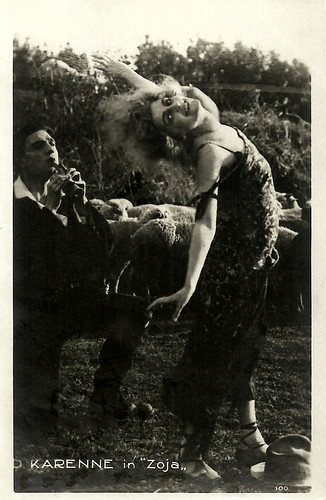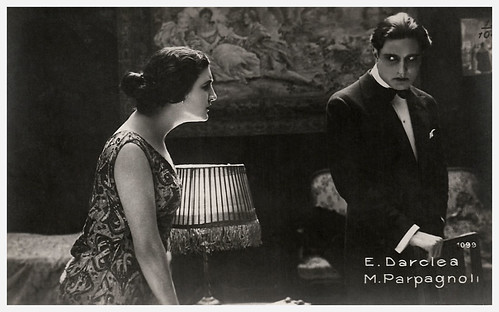
Italian postcard by Ed. A. Traldi, Milano, no. 35. Photo: Pinto, Roma.

Italian postcard by Ed. G. Vettori, Bologna, no. 188.
Two films that made history
Mario Parpagnoli started his career in 1917 in the Italian silent film L’aquila by Mario Gorgiulo, set in the Italian Risorgimento and based on a play by Arturo Colautti.
A countess who sleeps with two men, has two sons: one is pro-Austrian (played by Parpagnoli), the other pro-Italy (Ubaldo Maria del Colle).
Parpagnoli then acted in two films by Anton Giulio Bragaglia that made history. One is a lost film: Il mio cadavere, which Bragaglia codirected (uncredited) with Riccardo Cassano. It is based on the novel Francesco Lannas (1851) by Francesco Mastriani. Sets were by the Futurist Enrico Prampolini.
Parpagnoli had the male lead as the penniless composer Daniele who hopes for fortune & fame in Naples, but is refused the hand of a young contess until he earns a million. Emigrated, he meets an old gentleman who nominates him his heir. To speed up things Daniele kills the old man, inherits and runs to Naples to marry his countess. But then Daniele discovers that he killed his own father and goes berserk.
Parpagnoli's other film, directed by Bragaglia and Cassano is Thais. Leading actress was Thais Galitzky as an extravagant and cruel femme fatale, who meets her equal in a cold count (Parpagnoli), who rejects both her and her friend Bianca (Ileana Leonidoff).
When Thais finally manages to melt the count’s heart and then rejects him, she tells so to Bianca, who is madly in love with the count. Bianca rides away on her horse in a maddening galop and is killed underway. Thais then repents and kills herself by mortal vapours which exit from strange eye-shaped gaps in her room.
The futurist sets were designed again by Enrico Prampolini. A print of Thais was found and restored in Paris, although it is incomplete.

Italian postcard by Vettori, Bologna. Photo: publicity still of Diana Karenne in the Italian silent film Zoya or Zoja (Giulio Antamoro, 1920), a Tiber Film production. The man left might be Mario Parpagnoli.

Italian postcard, no. 1099. Edy Darclea and Mario Parpagnoli. Darclea and Parpagnoli played together in two films, Martino il trovatello (Alberto Capozzi, Ubaldo Maria Del Colle, 1919) and La valse ardente (Torello Rolli, 1921).
Hunting for the fortune of a bonvivant
After some neglectable dramas (a.o. with Claretta Rosaj) and a propaganda film, Mario Parpagnoli played the male lead role in the comedy L’Ultimo dei Cognac (Riccardo Cassano, 1918), based on a story by the famous Trilussa, and dealing with heirs hunting for the fortune of a bonvivant.
After a minor role in Martino il trovatello (Alberto Capozzi, 1919), Parpagnoli played the lover of Diana Karenne in La peccatrice casta (Gennaro Righelli, 1919) and again in La signora delle rose (Diana Karenne, 1919).
Next he was the lover of Vittoria Lepanto in Per aver visto (Enrico Roma, 1920).
In 1920 Parpagnoli peaked with some 10 films in one year. While he had a minor part in the divafilm Chimere (Baldassarre Negroni, 1920) starring Hesperia, he had the male lead opposite Rina Maggi in La complice muta (Livio Pavanelli, 1921), and opposite Pauline Polaire in L’istinto (Baldassarre Negroni, 1920), about a rich writer falling in love with a poor thief.
After the neglectable Liberazione (Jacques Creusy, 1921) and a supporting part in the divafilm Zoya (Giulio Antamoro, 1920) with Diana Karenne, Parpagnoli had the male lead opposite Francesca Bertini in three films.
These were La sfinge (Roberto Roberti, 1921), based on Feuillet’s Le sphynx (1874), Marion, artista di caffè-concerto (Roberto Roberti, 1920), based on Annie Vivanti’s novel, and Maddalena Ferat (Roberto Roberti, 1921), based on Emile Zola’s Madeleine (1865). All three were produced by Francesca Bertini’s own company.
After another Bertini film L’ultimo sogno (Roberto Roberti, 1921), Parpagnoli was the adventurer who ruins a princess’s family life in La valse ardente (Augusto Genina, 1921), with Edy Darclea and Marcella Sabattini.
The story was shamelessly copied from Bertini's earlier divafilm Sangue bleu (Nino Oxilia, 1914).

Italian postcard by Ed. G.B. Falci, Milano. Photo: publicity still of Francesca Bertini and Mario Parpagnoli in Ultimo sogno (Roberto Roberti, 1921).

Italian postcard by Ed. G.B. Falci, Milano. Photo: publicity still of Francesca Bertini in Ultimo sogno (Roberto Roberti, 1921). The man could be the male protagonist, played by Mario Parpagnoli.
Haunted by letters of young Venetian girl
In 1922 Mario Parpagnoli was the rival of Sandro Salvini in La fanciulla, il poeta e la laguna by Carmine Gallone.
Parpagnoli is a poet, haunted by letters of young Venetian girl. Cynically and proudly, he asks his secretary to respond to the girl…
He appeared in various films by Toddi starring Vera D’Angara, including the ghost story Al confine della morte (Toddi, 1922), for which Parpagnoli’s performance and the photography by Romagnoli were praised.
Others were Fu cosí che… (Toddi, 1922) and L’amore e il codicillo (Toddi, 1923).
He had a supporting part as bad guy in La rosa di Fortunio (Luciano Doria, 1922) with Diomira Jacobini and Lido Manetti, and another one in the Pina Menichelli vehicle L’ospite sconosciuta (Telemaco Ruggeri, 1923).
It was probably on the set of Mario Bonnard’s adaptation of I promessi sposi/The Betrothed (1922) that Parpagnoli met his future wife, actress Emilia Vidali - daughter of film producer/director/actor Giovanni Enrico Vidali.
She played Lucia while he himself played the evil Don Rodrigo. Italian critics considered the film 'too grey', but audiences loved it and the film was awarded a golden medal at a film festival in Turin in 1923.
For Emilia Vidali, who had been away from the film set for several years, it didn’t mean a full comeback, and after one more film, Amore e destino/Love and Fate (1923) directed by Parpagnoli and with Vidali and Parpagnoli in the leads, she left the Italian screen again.
Vidali and Parpagnoli had married in the meantime. Because of the crisis in the Italian cinema, the couple emigrated to Argentine.
There they played in the film Galleguita (Julio Irigoyen, 1924). In 1930 Parpagnoli scripted and directed in Buenos Aires the musical film Adios Argentina/Goodbye Argentina, in which Mexican star Libertad Lamarque had her debut.
Adios Argentina was originally made as a silent film, but later a soundtrack was added. This succesful tango film starred Ada Cornaro and Pierina Dealessi.
While Vidali returned to Europe in 1930, Parpagnoli remained in Argentine, working as official for the Empresas Filmadroas Italianas in the 1950s.

Italian postcard by U.C.I.G. / Vettori, Bologna. Photo: publicity still for the film I promessi sposi (Mario Bonnard, 1922), one of several adaptations of Alessandro Manzoni's famous novel, set in 17th century Italy. Caption: "Let me kill that infamous traitor!"

Italian postcard by U.C.I.G. / Vettori, Bologna. Photo: publicity stll for the film I promessi sposi (Mario Bonnard, 1922), one of several adaptations of Alessandro Manzoni's famous novel, set in 17th century Italy. Caption: "Begone this instant, and with unscathed limbs or we'll see."
Sources: Vittorio Martinelli (Il cinema muto italiano, 1917-1930) (Italian), Wikipedia and IMDb.
1 comment:
Love these silent film images. The costumes were wonderful and made with such skill. Of course back then many more people knew how to sew.
Post a Comment